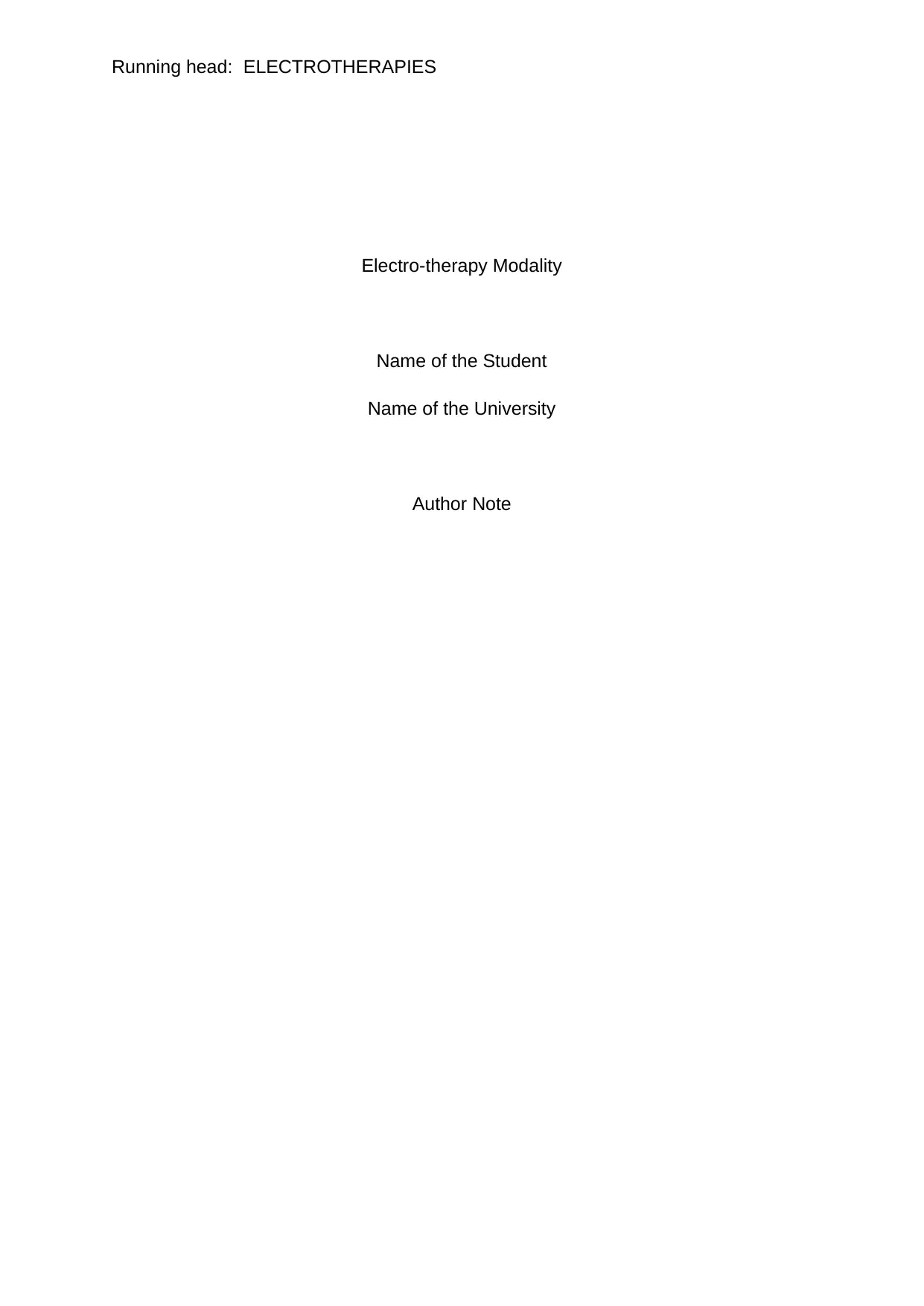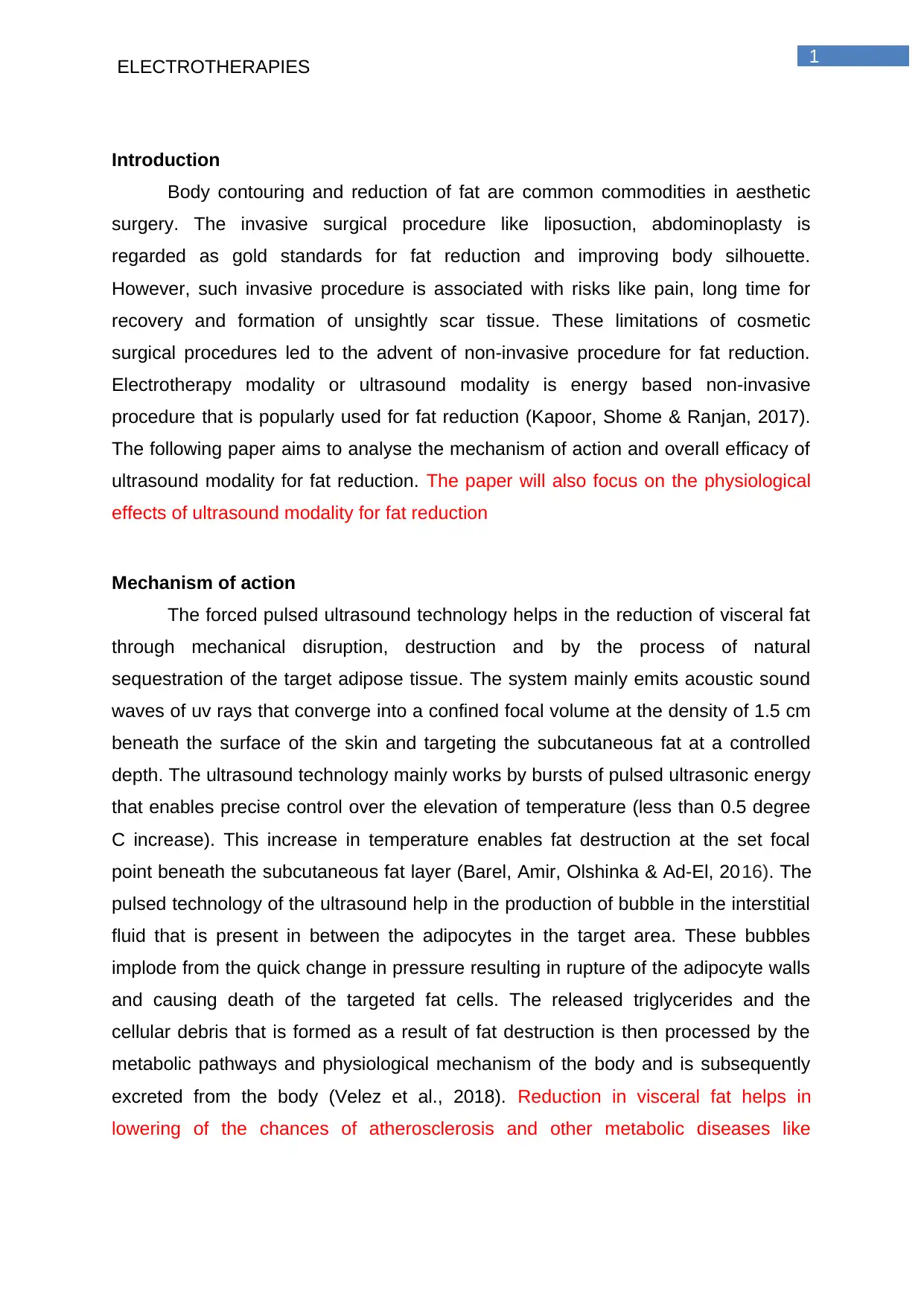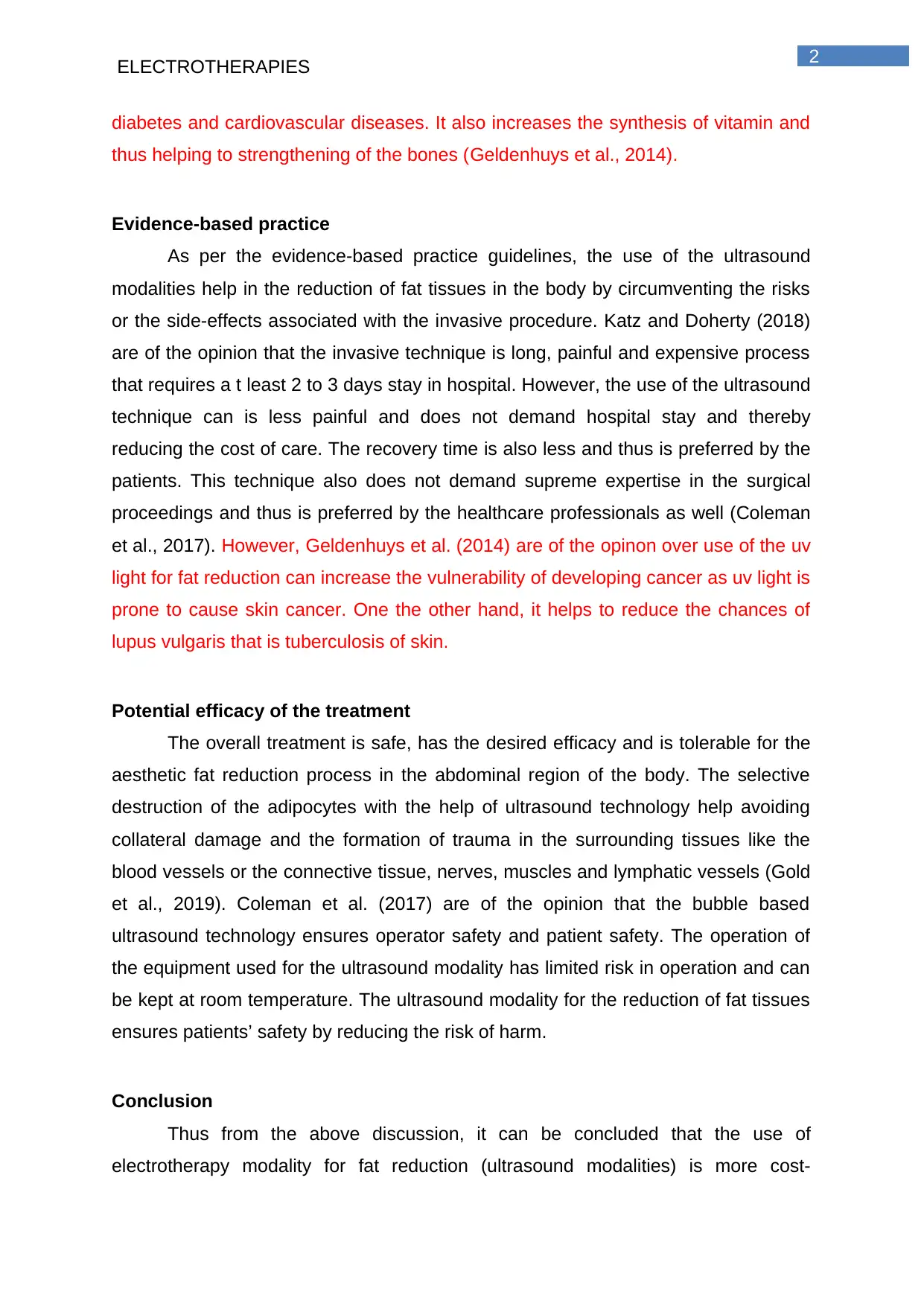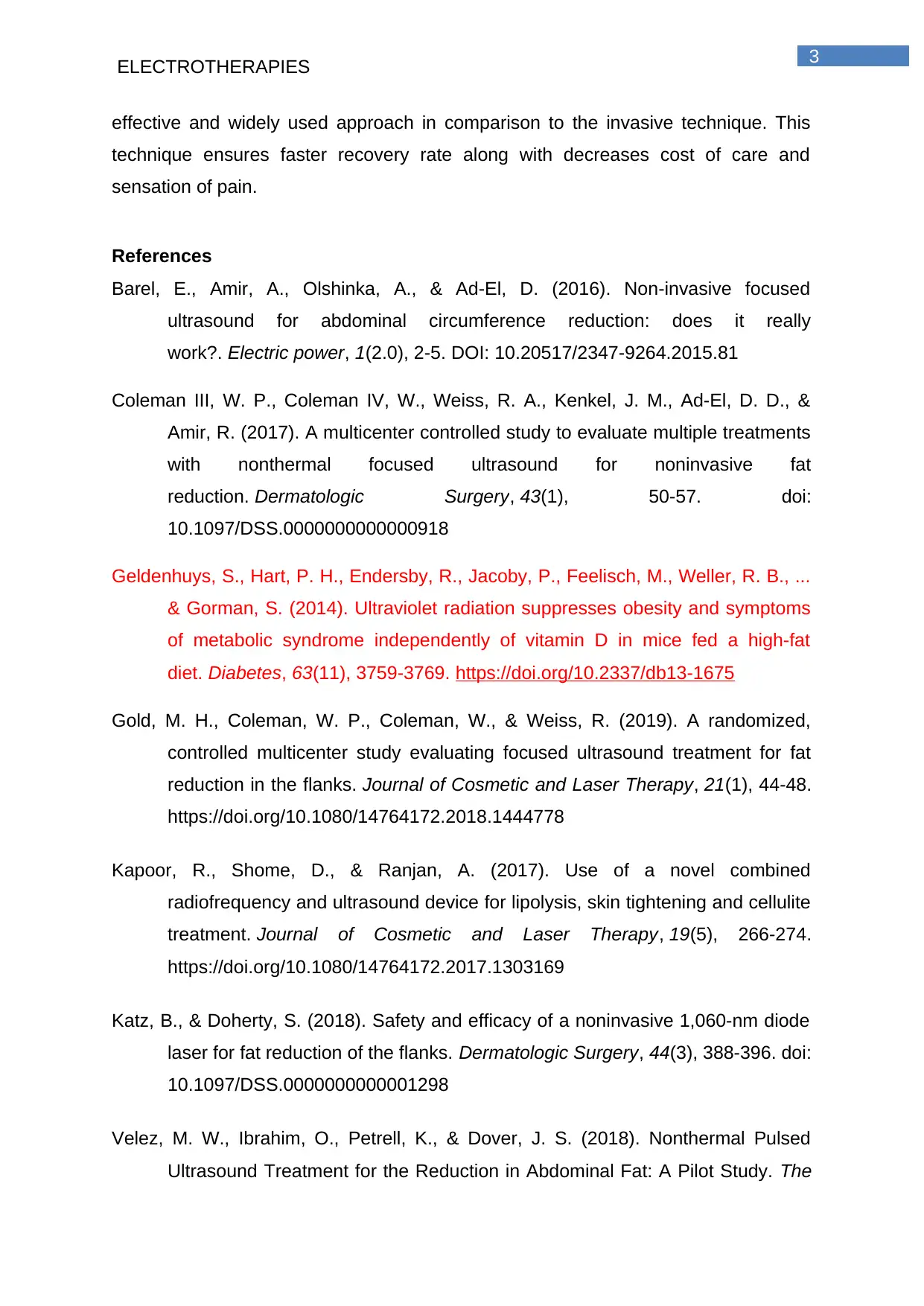Electro-therapy Modality Research Paper 2022
VerifiedAdded on 2022/10/10
|5
|1207
|11
AI Summary
Contribute Materials
Your contribution can guide someone’s learning journey. Share your
documents today.

Running head: ELECTROTHERAPIES
Electro-therapy Modality
Name of the Student
Name of the University
Author Note
Electro-therapy Modality
Name of the Student
Name of the University
Author Note
Secure Best Marks with AI Grader
Need help grading? Try our AI Grader for instant feedback on your assignments.

1
ELECTROTHERAPIES
Introduction
Body contouring and reduction of fat are common commodities in aesthetic
surgery. The invasive surgical procedure like liposuction, abdominoplasty is
regarded as gold standards for fat reduction and improving body silhouette.
However, such invasive procedure is associated with risks like pain, long time for
recovery and formation of unsightly scar tissue. These limitations of cosmetic
surgical procedures led to the advent of non-invasive procedure for fat reduction.
Electrotherapy modality or ultrasound modality is energy based non-invasive
procedure that is popularly used for fat reduction (Kapoor, Shome & Ranjan, 2017).
The following paper aims to analyse the mechanism of action and overall efficacy of
ultrasound modality for fat reduction. The paper will also focus on the physiological
effects of ultrasound modality for fat reduction
Mechanism of action
The forced pulsed ultrasound technology helps in the reduction of visceral fat
through mechanical disruption, destruction and by the process of natural
sequestration of the target adipose tissue. The system mainly emits acoustic sound
waves of uv rays that converge into a confined focal volume at the density of 1.5 cm
beneath the surface of the skin and targeting the subcutaneous fat at a controlled
depth. The ultrasound technology mainly works by bursts of pulsed ultrasonic energy
that enables precise control over the elevation of temperature (less than 0.5 degree
C increase). This increase in temperature enables fat destruction at the set focal
point beneath the subcutaneous fat layer (Barel, Amir, Olshinka & Ad-El, 2016). The
pulsed technology of the ultrasound help in the production of bubble in the interstitial
fluid that is present in between the adipocytes in the target area. These bubbles
implode from the quick change in pressure resulting in rupture of the adipocyte walls
and causing death of the targeted fat cells. The released triglycerides and the
cellular debris that is formed as a result of fat destruction is then processed by the
metabolic pathways and physiological mechanism of the body and is subsequently
excreted from the body (Velez et al., 2018). Reduction in visceral fat helps in
lowering of the chances of atherosclerosis and other metabolic diseases like
ELECTROTHERAPIES
Introduction
Body contouring and reduction of fat are common commodities in aesthetic
surgery. The invasive surgical procedure like liposuction, abdominoplasty is
regarded as gold standards for fat reduction and improving body silhouette.
However, such invasive procedure is associated with risks like pain, long time for
recovery and formation of unsightly scar tissue. These limitations of cosmetic
surgical procedures led to the advent of non-invasive procedure for fat reduction.
Electrotherapy modality or ultrasound modality is energy based non-invasive
procedure that is popularly used for fat reduction (Kapoor, Shome & Ranjan, 2017).
The following paper aims to analyse the mechanism of action and overall efficacy of
ultrasound modality for fat reduction. The paper will also focus on the physiological
effects of ultrasound modality for fat reduction
Mechanism of action
The forced pulsed ultrasound technology helps in the reduction of visceral fat
through mechanical disruption, destruction and by the process of natural
sequestration of the target adipose tissue. The system mainly emits acoustic sound
waves of uv rays that converge into a confined focal volume at the density of 1.5 cm
beneath the surface of the skin and targeting the subcutaneous fat at a controlled
depth. The ultrasound technology mainly works by bursts of pulsed ultrasonic energy
that enables precise control over the elevation of temperature (less than 0.5 degree
C increase). This increase in temperature enables fat destruction at the set focal
point beneath the subcutaneous fat layer (Barel, Amir, Olshinka & Ad-El, 2016). The
pulsed technology of the ultrasound help in the production of bubble in the interstitial
fluid that is present in between the adipocytes in the target area. These bubbles
implode from the quick change in pressure resulting in rupture of the adipocyte walls
and causing death of the targeted fat cells. The released triglycerides and the
cellular debris that is formed as a result of fat destruction is then processed by the
metabolic pathways and physiological mechanism of the body and is subsequently
excreted from the body (Velez et al., 2018). Reduction in visceral fat helps in
lowering of the chances of atherosclerosis and other metabolic diseases like

2
ELECTROTHERAPIES
diabetes and cardiovascular diseases. It also increases the synthesis of vitamin and
thus helping to strengthening of the bones (Geldenhuys et al., 2014).
Evidence-based practice
As per the evidence-based practice guidelines, the use of the ultrasound
modalities help in the reduction of fat tissues in the body by circumventing the risks
or the side-effects associated with the invasive procedure. Katz and Doherty (2018)
are of the opinion that the invasive technique is long, painful and expensive process
that requires a t least 2 to 3 days stay in hospital. However, the use of the ultrasound
technique can is less painful and does not demand hospital stay and thereby
reducing the cost of care. The recovery time is also less and thus is preferred by the
patients. This technique also does not demand supreme expertise in the surgical
proceedings and thus is preferred by the healthcare professionals as well (Coleman
et al., 2017). However, Geldenhuys et al. (2014) are of the opinon over use of the uv
light for fat reduction can increase the vulnerability of developing cancer as uv light is
prone to cause skin cancer. One the other hand, it helps to reduce the chances of
lupus vulgaris that is tuberculosis of skin.
Potential efficacy of the treatment
The overall treatment is safe, has the desired efficacy and is tolerable for the
aesthetic fat reduction process in the abdominal region of the body. The selective
destruction of the adipocytes with the help of ultrasound technology help avoiding
collateral damage and the formation of trauma in the surrounding tissues like the
blood vessels or the connective tissue, nerves, muscles and lymphatic vessels (Gold
et al., 2019). Coleman et al. (2017) are of the opinion that the bubble based
ultrasound technology ensures operator safety and patient safety. The operation of
the equipment used for the ultrasound modality has limited risk in operation and can
be kept at room temperature. The ultrasound modality for the reduction of fat tissues
ensures patients’ safety by reducing the risk of harm.
Conclusion
Thus from the above discussion, it can be concluded that the use of
electrotherapy modality for fat reduction (ultrasound modalities) is more cost-
ELECTROTHERAPIES
diabetes and cardiovascular diseases. It also increases the synthesis of vitamin and
thus helping to strengthening of the bones (Geldenhuys et al., 2014).
Evidence-based practice
As per the evidence-based practice guidelines, the use of the ultrasound
modalities help in the reduction of fat tissues in the body by circumventing the risks
or the side-effects associated with the invasive procedure. Katz and Doherty (2018)
are of the opinion that the invasive technique is long, painful and expensive process
that requires a t least 2 to 3 days stay in hospital. However, the use of the ultrasound
technique can is less painful and does not demand hospital stay and thereby
reducing the cost of care. The recovery time is also less and thus is preferred by the
patients. This technique also does not demand supreme expertise in the surgical
proceedings and thus is preferred by the healthcare professionals as well (Coleman
et al., 2017). However, Geldenhuys et al. (2014) are of the opinon over use of the uv
light for fat reduction can increase the vulnerability of developing cancer as uv light is
prone to cause skin cancer. One the other hand, it helps to reduce the chances of
lupus vulgaris that is tuberculosis of skin.
Potential efficacy of the treatment
The overall treatment is safe, has the desired efficacy and is tolerable for the
aesthetic fat reduction process in the abdominal region of the body. The selective
destruction of the adipocytes with the help of ultrasound technology help avoiding
collateral damage and the formation of trauma in the surrounding tissues like the
blood vessels or the connective tissue, nerves, muscles and lymphatic vessels (Gold
et al., 2019). Coleman et al. (2017) are of the opinion that the bubble based
ultrasound technology ensures operator safety and patient safety. The operation of
the equipment used for the ultrasound modality has limited risk in operation and can
be kept at room temperature. The ultrasound modality for the reduction of fat tissues
ensures patients’ safety by reducing the risk of harm.
Conclusion
Thus from the above discussion, it can be concluded that the use of
electrotherapy modality for fat reduction (ultrasound modalities) is more cost-

3
ELECTROTHERAPIES
effective and widely used approach in comparison to the invasive technique. This
technique ensures faster recovery rate along with decreases cost of care and
sensation of pain.
References
Barel, E., Amir, A., Olshinka, A., & Ad-El, D. (2016). Non-invasive focused
ultrasound for abdominal circumference reduction: does it really
work?. Electric power, 1(2.0), 2-5. DOI: 10.20517/2347-9264.2015.81
Coleman III, W. P., Coleman IV, W., Weiss, R. A., Kenkel, J. M., Ad-El, D. D., &
Amir, R. (2017). A multicenter controlled study to evaluate multiple treatments
with nonthermal focused ultrasound for noninvasive fat
reduction. Dermatologic Surgery, 43(1), 50-57. doi:
10.1097/DSS.0000000000000918
Geldenhuys, S., Hart, P. H., Endersby, R., Jacoby, P., Feelisch, M., Weller, R. B., ...
& Gorman, S. (2014). Ultraviolet radiation suppresses obesity and symptoms
of metabolic syndrome independently of vitamin D in mice fed a high-fat
diet. Diabetes, 63(11), 3759-3769. https://doi.org/10.2337/db13-1675
Gold, M. H., Coleman, W. P., Coleman, W., & Weiss, R. (2019). A randomized,
controlled multicenter study evaluating focused ultrasound treatment for fat
reduction in the flanks. Journal of Cosmetic and Laser Therapy, 21(1), 44-48.
https://doi.org/10.1080/14764172.2018.1444778
Kapoor, R., Shome, D., & Ranjan, A. (2017). Use of a novel combined
radiofrequency and ultrasound device for lipolysis, skin tightening and cellulite
treatment. Journal of Cosmetic and Laser Therapy, 19(5), 266-274.
https://doi.org/10.1080/14764172.2017.1303169
Katz, B., & Doherty, S. (2018). Safety and efficacy of a noninvasive 1,060-nm diode
laser for fat reduction of the flanks. Dermatologic Surgery, 44(3), 388-396. doi:
10.1097/DSS.0000000000001298
Velez, M. W., Ibrahim, O., Petrell, K., & Dover, J. S. (2018). Nonthermal Pulsed
Ultrasound Treatment for the Reduction in Abdominal Fat: A Pilot Study. The
ELECTROTHERAPIES
effective and widely used approach in comparison to the invasive technique. This
technique ensures faster recovery rate along with decreases cost of care and
sensation of pain.
References
Barel, E., Amir, A., Olshinka, A., & Ad-El, D. (2016). Non-invasive focused
ultrasound for abdominal circumference reduction: does it really
work?. Electric power, 1(2.0), 2-5. DOI: 10.20517/2347-9264.2015.81
Coleman III, W. P., Coleman IV, W., Weiss, R. A., Kenkel, J. M., Ad-El, D. D., &
Amir, R. (2017). A multicenter controlled study to evaluate multiple treatments
with nonthermal focused ultrasound for noninvasive fat
reduction. Dermatologic Surgery, 43(1), 50-57. doi:
10.1097/DSS.0000000000000918
Geldenhuys, S., Hart, P. H., Endersby, R., Jacoby, P., Feelisch, M., Weller, R. B., ...
& Gorman, S. (2014). Ultraviolet radiation suppresses obesity and symptoms
of metabolic syndrome independently of vitamin D in mice fed a high-fat
diet. Diabetes, 63(11), 3759-3769. https://doi.org/10.2337/db13-1675
Gold, M. H., Coleman, W. P., Coleman, W., & Weiss, R. (2019). A randomized,
controlled multicenter study evaluating focused ultrasound treatment for fat
reduction in the flanks. Journal of Cosmetic and Laser Therapy, 21(1), 44-48.
https://doi.org/10.1080/14764172.2018.1444778
Kapoor, R., Shome, D., & Ranjan, A. (2017). Use of a novel combined
radiofrequency and ultrasound device for lipolysis, skin tightening and cellulite
treatment. Journal of Cosmetic and Laser Therapy, 19(5), 266-274.
https://doi.org/10.1080/14764172.2017.1303169
Katz, B., & Doherty, S. (2018). Safety and efficacy of a noninvasive 1,060-nm diode
laser for fat reduction of the flanks. Dermatologic Surgery, 44(3), 388-396. doi:
10.1097/DSS.0000000000001298
Velez, M. W., Ibrahim, O., Petrell, K., & Dover, J. S. (2018). Nonthermal Pulsed
Ultrasound Treatment for the Reduction in Abdominal Fat: A Pilot Study. The
Secure Best Marks with AI Grader
Need help grading? Try our AI Grader for instant feedback on your assignments.

4
ELECTROTHERAPIES
Journal of clinical and aesthetic dermatology, 11(9), 32.
https://www.ncbi.nlm.nih.gov/pmc/articles/PMC6169596/
ELECTROTHERAPIES
Journal of clinical and aesthetic dermatology, 11(9), 32.
https://www.ncbi.nlm.nih.gov/pmc/articles/PMC6169596/
1 out of 5
Your All-in-One AI-Powered Toolkit for Academic Success.
+13062052269
info@desklib.com
Available 24*7 on WhatsApp / Email
![[object Object]](/_next/static/media/star-bottom.7253800d.svg)
Unlock your academic potential
© 2024 | Zucol Services PVT LTD | All rights reserved.